Introduction: A comparison between Kalamkari and Madhubani
Indian art is full of diversity having artistic, historical and cultural significance. Among the plethora of traditional Indian crafts, Kalamkari and Madhubani stand out as iconic representations of Indian artistry and cultural richness. These two iconic art forms are not just visually captivating but contain a deeply symbolic representation.
Madhubani painting designs with geometric patterns resemble ancient traditions and Kalamkari with natural dyes resembles the art of storytelling. Each pattern and intricate design on these art forms capture the narration of the tales of history, spirituality and everyday life.
Even being so common in the sense of storytelling, what makes Kalamkari and Madhubani painting designs so different from each other? The comparisons lie within the techniques, style, history, and origin of these two Indian crafts. Whether you’re a traditional art enthusiast or someone who delved into the fashion world, this article will help you gain a deeper understanding to appreciate their nuances.
What is Madhubani painting designs?
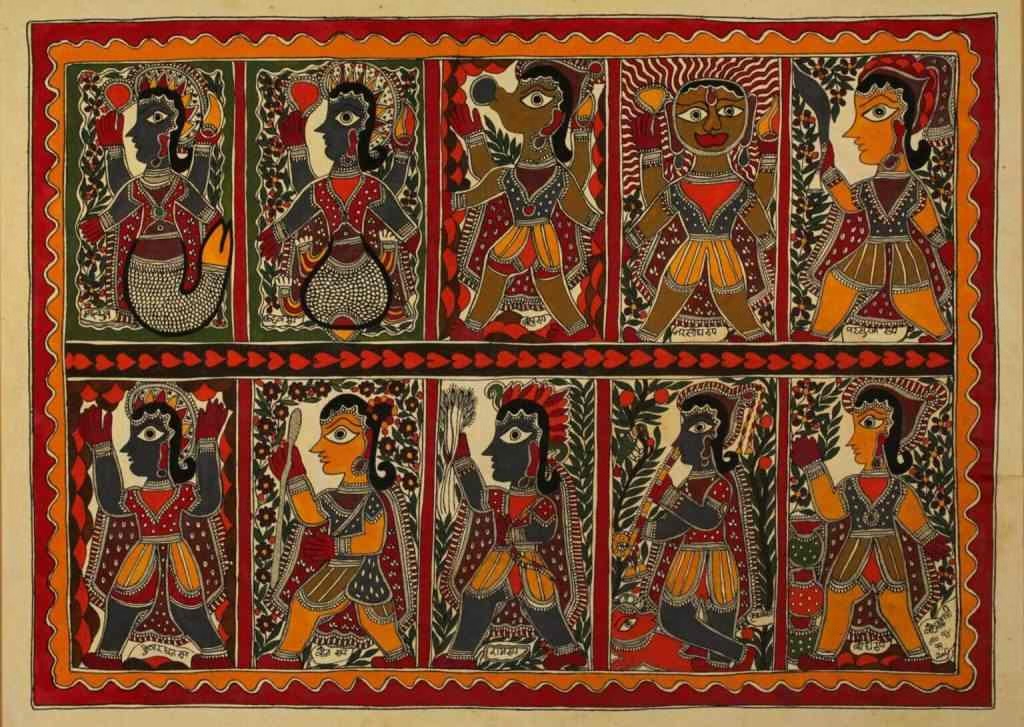
Madhubani painting designs is a traditional Indian art form that originates from Mithila of Bihar, and this is why it is also known as Mithila painting. Its bold designs, vibrant colours and intricate patterns depict the theme of nature, mythology and daily life. Madhubani painting design is created on the walls, paper or cotton fabric that narrates the stories of cultural richness.
This art form is believed to have been created in the era of Ramayana during the wedding of Mata Sita and Lord Rama. Traditionally, this Indian craft was practiced by women to decorate their walls at festivals or occasions to represent a deep connection to spirituality and nature.
The History of Madhubani painting designs. A Window into ancient India
The History of Madhubani painting designs is associated with an ancient religious epic folklore. This traditional art form is deeply rooted in the Ramayana era when Raja Janaka commissioned an artisan to decorate the walls of Mithila of Bihar to celebrate the marriage of his daughter Mata Sita and Lord Rama. This is when Madhubani art was created for the first time and now it is marked as a tradition that has been passed down for centuries.
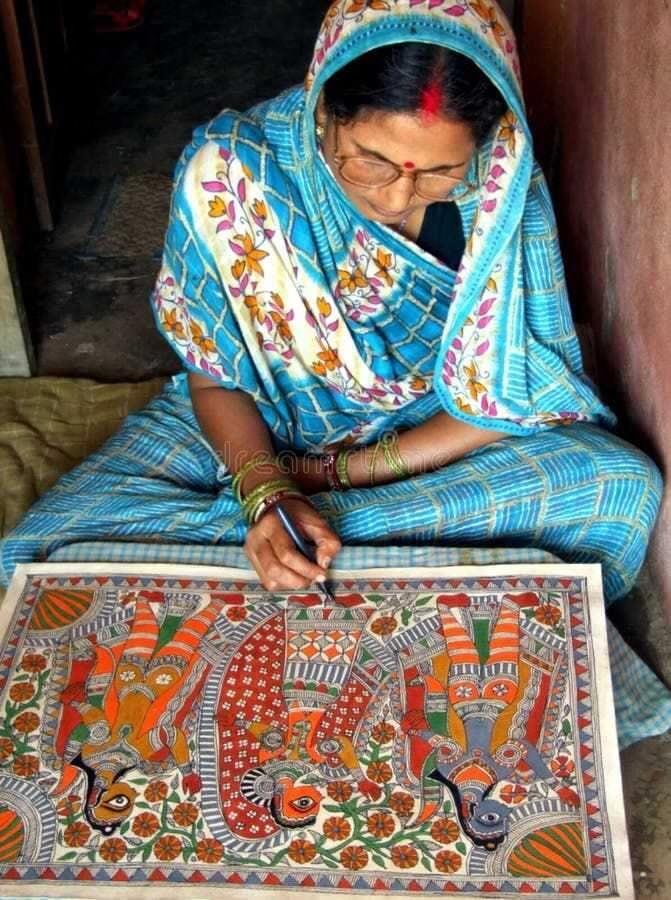
Historically, the women used to decorate their walls and floors with the unique designs of Madhubani art, using the natural dyes, derived from plants, clays and flowers. The symbolic pattern on the paintings was just for decoration but was a representation of a deep connection to blessings during weddings, childbirth, festivals or any auspicious occasions.
Madhubani transformed in the early 20th century when it was moved from wall art to other mediums like paper or cotton fabric. This change was made to bring an avenue of livelihood for women and to preserve the art form. Madhubani is not only popular in India, but its popularity hit the worldwide nation and social reformers, and government initiatives played a crucial role in promoting and spreading Madhubani painting designs over national and international platforms.
Today, Madhubani painting designs have made itself a name as a GI (geographical indication) product protecting its authenticity and the cultural heritage of the Mithila region of Bihar. The themed designs and intricate patterns are captivating for art enthusiasts and also inspire modern art and artists ensuring that this ancient art form continues to thrive in the contemporary world.
What is Kalamkari?
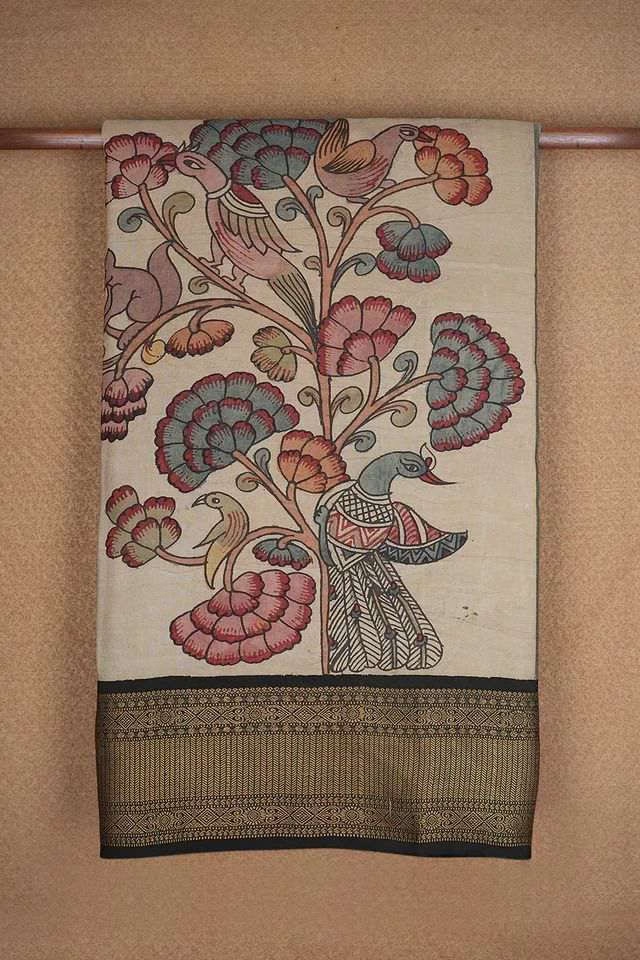
Kalamkari originates from the Persian words ‘Kalam’, which means pen, and’ Kari’, which means art or craftsmanship. Kalamkari is an ancient art form that involves hand-painting or block-printing on a fabric, depicting Hindu sculptures and history. This art revolves around storytelling which narrates the episodes of mythology, folklore and tales of religious epics, Mahabharata and Ramayana through its intricate designs and vibrant patterns.
Kalamkari is rooted in the Andra Pradesh and Telangana region, where the artisans craft these designs on cotton and silk fabric using natural dyes. These designs are popular for the choice of home decor, apparel and wall art due to their versatility and elegance.
The history of Kalamkari. How has it become a timeless Indian art form?
Kalamkari art form is believed to have originated 3000 years ago, an artistic technique that intertwined artistry with spirituality and cultural exchange. Earlier Kalamkari started as a sacred craft to illustrate and represent the mythological tales and epics on walls of temples and scrolls. The art was previously done by priests and temple dwellers who used natural dyes and bamboo pens to create intricate patterns the narrated the stories and episodes of Hindu epics like Ramayana and Mahabharata.
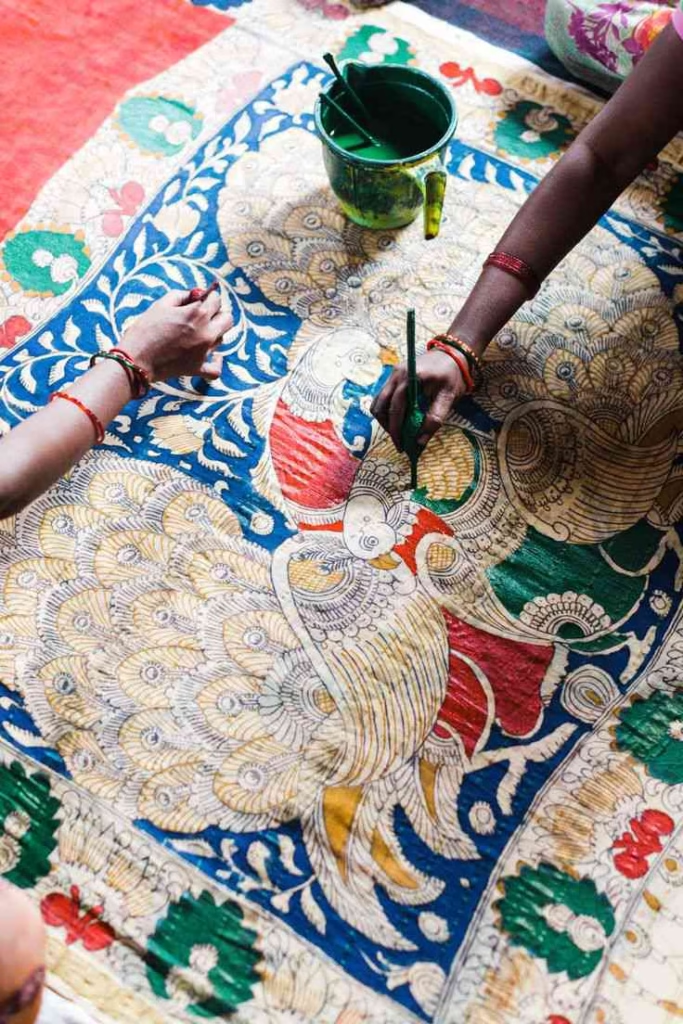
During the medieval period, Kalamkari art flourished in the patronage of the Mughal Empire and Golkonda Sultanate, which brought Persian influence over the art form. These influences introduced the decoration of floral and designing motifs in the patterns that add a layer of sophistication to the craft. The rulers Jehangir and Shah Jahan played a crucial role in advancing and promoting this art form. The name given to this painting ‘Kalamkari’ itself reflects the cross-cultural exchange as its meaning is derived from the Persian words ‘kalam’ and ‘kari’.
Another significant phase in the Kalamkari history was the colonial era. European traders, mainly British and Dutch, admired the beauty and vibrant hues of this craft, making it a prized export. The fabrics adorned with Kalamkari design found their way to European homes, becoming the global recognition for Indian craft.
Despite the advent of modern techniques for textile printing, Kalamkari thrives to remain a timeless Indian art, a symbol of captivating history and cultural heritage. Today, this art form is not just limited to temple walls or floors, but become a choice for interior designs, fashion and contemporary decor, that bridges ancient and modern art.
How are Madhubani and Kalamkari made? Their artistic techniques
Kalamkari and Madhubani painting designs might be similar in their look, but they are different in the techniques and methods used to create them.
Kalamkari: The artistry in Kalamkari is done with the help of bamboo pen to draw intricate designs and then natural dyes are applied to it. The process of creating Kalamkari includes multiple elaborate steps like bleaching, softening, hand-painting, washing and sun-drying the fabrics. The steps are labor-intensive yet rewarding giving the best work of craftsmanship.
Madhubani: The artists use brushes, fingers or twigs to create geometrical patterns and sparkling colours. Natural materials are used such as cow dung, powdered rice and charcoals to add an earthy charm to its appeal. The process of creating this art form is precise and carefully hand-drawn so need to use stencils or rulers. The paintings when done are left to dry naturally and then they last for a decade.
These art forms have exceptional artistic craftmanship that require both patience and dedication of the artists.
Themes and motifs: What stories do they tell?
Both kalamkari and Madhubani painting designs are deeply rooted in storytelling that reflects the history’s richness of a country.
Kalamkari: The designs are based on mythological epics and its theme depicts the episodes of ancient tales, including the floral motifs.
Madhubani: The themes of Madhubani painting designs are focused on Hindu spiritual deities, nature (sun, moon, fish, flowers and trees), women and celebration of life. The patterns represent the symbols of spirituality, fertility and prosperity.
The stories capture the essence of cultural richness, offering a glimpse of the beliefs and traditions of the regions.
Colors and materials: A unique palate of tradition
The colors that are used to make both kalamkari and Madhubani are sourced from natural materials making both of them the emblem of trdition and sustainability.
Kalamkari painting designs: The colors used in the making of kalamkari are earthy hues like mustard, rust, indigo, black and green derived from natural sources without any chemical or artificial paints. The materials like blending jaggery with water and iron fillings to extract black for outlining and sketching, sourcing mustard and yellow color by boiling pomegranate peels and using the bark of Algarin for getting red hues. Colors like indigo and green are formed by mixing other colors into each other.
Madhubani painting designs: Madhubani art is created by using natural pigments and dyes. Bold shades of color like red, green, black, white and yellow are used, which is sourced from natural elements such as powdered rice for getting white, sandalwood for extracting red, pollen or turmeric for getting yellow and plants and flowers for getting other vibrant colors.
Influence and Patronage: How Do These Arts Reflect difference?
The influence of both Indian crafts is different that resembles in their style and designs
Kalamkari: The designs of kalamkari have Persian and Islamic influence due to Mughal and Bahami rulers, and received patronage from Mughals, British and Golkonda.
Madhubani: Madhubani, being a traditional folk art of the Mithila region has a Hindu influence, where the Tulsi plant – ‘a resemblance of blessing and spirituality’, appears in the designs of the paintings. This art form is carried over by locals without much patronage.
Medium of Expression: From walls to fabrics
The medium of any art form is an expression of the cultural origins and the purpose it serves. For both Kalamkari and Madhubani. their medium represents the canvas of creativity and artistry.
Kalamkari: The primary medium of this art is textiles, where designs are created through hand-painting or block printing onto cotton or silk fabrics. The fabrics are prepared by soaking in cow dung and bleach, washing and sun-drying before painting into it. Traditionally, used for temple-hanging and garments, the designs show the fine detailing that complements the fluidity of fabrics.
Madhubani: Earlier, Madhubani painting designs are created over mud walls, floors and house doors. After that, it expanded over mediums like handmade paper, cloth, sarees and canvas. The artists prepare the walls by applying mud or cow dung to make a smoother surface.
Global recognition: How did Kalamkari and Madhubani painting designs reach the Modern World?
Kalamkari and Madhubani, India’s most cherished art forms have gained global recognition and represent the cultural richness of a country. Kalamkari was introduced to the international market during the colonial era by European traders. The detailed storytelling of Kalamkari through textiles is captivating, and this is what brings this art form into museums and home decor. The modern fashion has approached a different sense of style with these intricate designs on garments, dress, shawls, etc., depicting the art of storytelling.
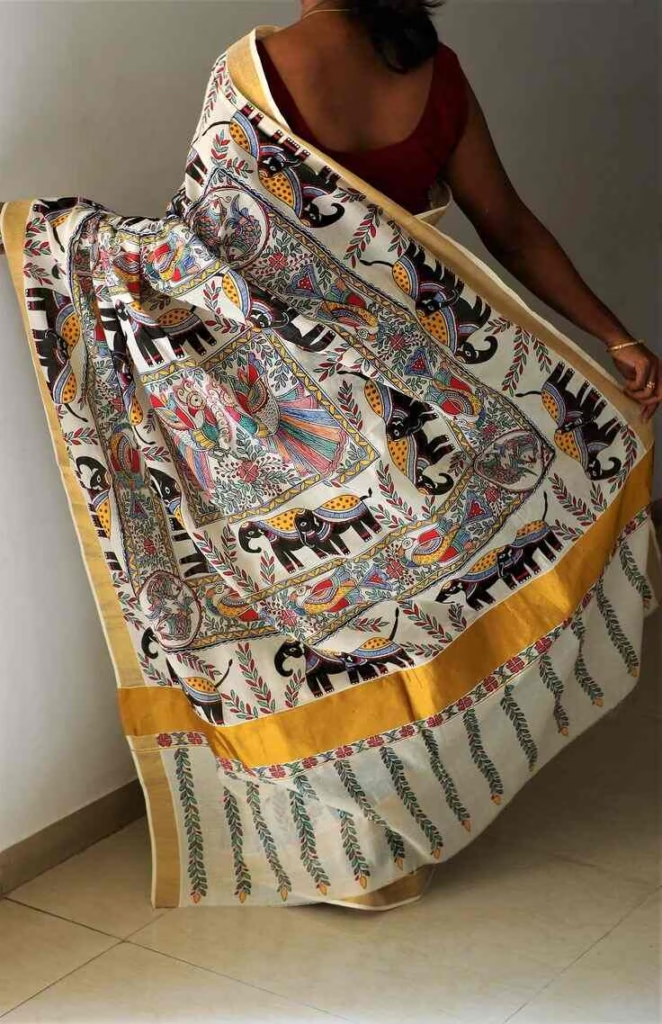
Madhubani painting designs found the global recognition in the mid 20th century with the help of cultural activists and government initiatives. Transitioning the art form from walls to canvas and fabrics opened its door to global fashion, exhibitions and galleries. The modern designers and digital creators promoting Madhubani art through sarees, dresses, shawls, etc., showcasing their vibrant and bold patterns.
What makes both arts relevant today is their timeless ability to bridge tradition with modernity. These are versatile Indian art that thrives on a journey of artistic and dedicated craftsmanship, and their recognition and relevancy is an honor of artists carrying the traditional legacy and passing the skills through generations.
Conclusion: The timeless alure of Kalamkari and Madhubani
The relevance of both Kalamkari and Madhubani painting designs lies in their authenticity and artistry. Choosing between them is like picking a favorite star- they both shine on their way. Both of them are complex and require patience and dedication to bring the masterpiece art. Together, they symbolize the country’s rich artistic legacy and tradition, cherished by art enthusiasts.
These crafts are getting a new dimension not only in art but in education, community development and mental wellness. As more people are adapting the art forms, they understand the therapeutic value of engaging with such intricate crafts. Kalamkari and Madhubani are much more than just an aesthetic visual, these are the alluring mediums to connect people across time and geography.
The initiatives taken by the people of art activists is quite impressing. Events and workshops to support these art form, ensuring that their history and significance reach to our new generation and evoke the interest of both Kalamkari and Madhubani painting designs. Embracing these Indian art forms is a perseverance of cultural heritage that enriches the understanding of art, culture, dedication and life itself.
For further reading on the significance of both the arts, you can visit these useful resources:
Check out our Blog Page on Traditional Indian art.

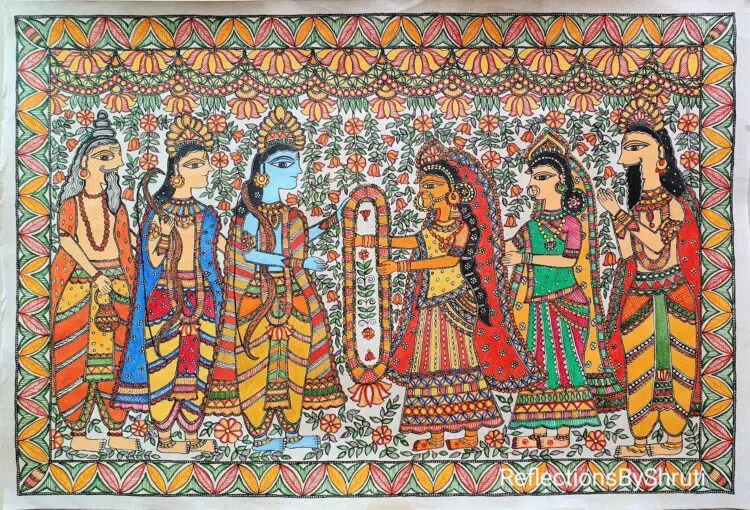

Leave a Reply